Cellular transcription factor ZASC1 regulates murine leukemia virus transcription
- PMID: 20484494
- PMCID: PMC2897642
- DOI: 10.1128/JVI.00299-10
Cellular transcription factor ZASC1 regulates murine leukemia virus transcription
Abstract
To identify cellular processes involved in retroviral infection, we employed a high-volume forward genetic screen of insertionally mutagenized somatic cells using a murine leukemia virus (MLV) vector. This approach identified a clonal cell line that exhibited approximately 10-fold reduced gene expression from MLV vectors following infection despite supporting normal levels of MLV reverse transcription and integration. The defect in this cell line was specific for the MLV long terminal repeat (LTR) promoter, as normal levels of reporter gene expression were obtained from both an internal cytomegalovirus (CMV) promoter contained within an LTR-defective MLV vector and LTR expression from an avian sarcoma and leukosis virus (ASLV) vector. Complementation and shRNA knockdown experiments demonstrated that the defective gene in these cells is ZASC1 (ZNF639), a transcription factor with strong links to cancer and inherited ataxias. We demonstrated that ZASC1 is a sequence-specific DNA binding protein with three closely related binding sites located within the MLV LTR promoter, but it does not bind to the ASLV promoter. Mutating these putative ZASC1 binding sites significantly reduced levels of MLV gene expression. While wild-type ZASC1 activated expression from the MLV promoter, a green fluorescent protein-ZASC1 fusion protein showed dominant-negative inhibition of MLV gene expression. These studies identify the cellular transcription factor ZASC1 as an activator of MLV gene expression and provide tools that should be useful in studying the links between ZASC1 and human diseases.
Figures


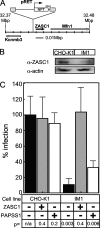
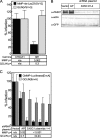

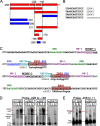

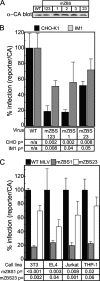
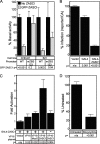
Similar articles
-
Isolation of cell lines that show novel, murine leukemia virus-specific blocks to early steps of retroviral replication.J Virol. 2005 Oct;79(20):12969-78. doi: 10.1128/JVI.79.20.12969-12978.2005. J Virol. 2005. PMID: 16188999 Free PMC article.
-
A murine leukemia virus (MuLV) long terminal repeat derived from rhesus macaques in the context of a lentivirus vector and MuLV gag sequence results in high-level gene expression in human T lymphocytes.J Virol. 2000 Apr;74(8):3668-81. doi: 10.1128/jvi.74.8.3668-3681.2000. J Virol. 2000. PMID: 10729143 Free PMC article.
-
BET-Independent Murine Leukemia Virus Integration Is Retargeted In Vivo and Selects Distinct Genomic Elements for Lymphomagenesis.Microbiol Spectr. 2022 Aug 31;10(4):e0147822. doi: 10.1128/spectrum.01478-22. Epub 2022 Jul 19. Microbiol Spectr. 2022. PMID: 35852337 Free PMC article.
-
Amphotropic murine leukemia virus replication in human mammary epithelial cells and the formation of cytomegalovirus-promoter recombinants.Virology. 2001 Dec 5;291(1):91-100. doi: 10.1006/viro.2001.1199. Virology. 2001. PMID: 11878879
-
Insights into the nuclear export of murine leukemia virus intron-containing RNA.RNA Biol. 2015;12(9):942-9. doi: 10.1080/15476286.2015.1065375. RNA Biol. 2015. PMID: 26158194 Free PMC article. Review.
Cited by
-
Differences in gene expression between mouse and human for dynamically regulated genes in early embryo.PLoS One. 2014 Aug 4;9(8):e102949. doi: 10.1371/journal.pone.0102949. eCollection 2014. PLoS One. 2014. PMID: 25089626 Free PMC article.
-
Repair of APOBEC3G-Mutated Retroviral DNA In Vivo Is Facilitated by the Host Enzyme Uracil DNA Glycosylase 2.J Virol. 2021 Oct 27;95(22):e0124421. doi: 10.1128/JVI.01244-21. Epub 2021 Sep 1. J Virol. 2021. PMID: 34468176 Free PMC article.
-
ZASC1 knockout mice exhibit an early bone marrow-specific defect in murine leukemia virus replication.Virol J. 2013 Apr 24;10:130. doi: 10.1186/1743-422X-10-130. Virol J. 2013. PMID: 23617998 Free PMC article.
-
A cis-Acting Element Downstream of the Mouse Mammary Tumor Virus Major Splice Donor Critical for RNA Elongation and Stability.J Mol Biol. 2018 Oct 19;430(21):4307-4324. doi: 10.1016/j.jmb.2018.08.025. Epub 2018 Sep 1. J Mol Biol. 2018. PMID: 30179605 Free PMC article.
-
Zinc Finger Protein 639 Expression Is a Novel Prognostic Determinant in Breast Cancer.J Breast Cancer. 2025 Apr;28(2):86-98. doi: 10.4048/jbc.2024.0224. Epub 2025 Mar 9. J Breast Cancer. 2025. PMID: 40133986 Free PMC article.
References
-
- Bates, P., J. A. Young, and H. E. Varmus. 1993. A receptor for subgroup A Rous sarcoma virus is related to the low density lipoprotein receptor. Cell 74:1043-1051. - PubMed
-
- Bogaerts, S., A. Vanlandschoot, J. van Hengel, and F. van Roy. 2005. Nuclear translocation of alphaN-catenin by the novel zinc finger transcriptional repressor ZASC1. Exp. Cell Res. 311:1-13. - PubMed
-
- Brass, A. L., D. M. Dykxhoorn, Y. Benita, N. Yan, A. Engelman, R. J. Xavier, J. Lieberman, and S. J. Elledge. 2008. Identification of host proteins required for HIV infection through a functional genomic screen. Science 319:921-926. - PubMed
Publication types
MeSH terms
Substances
Grants and funding
LinkOut - more resources
Full Text Sources
Molecular Biology Databases

